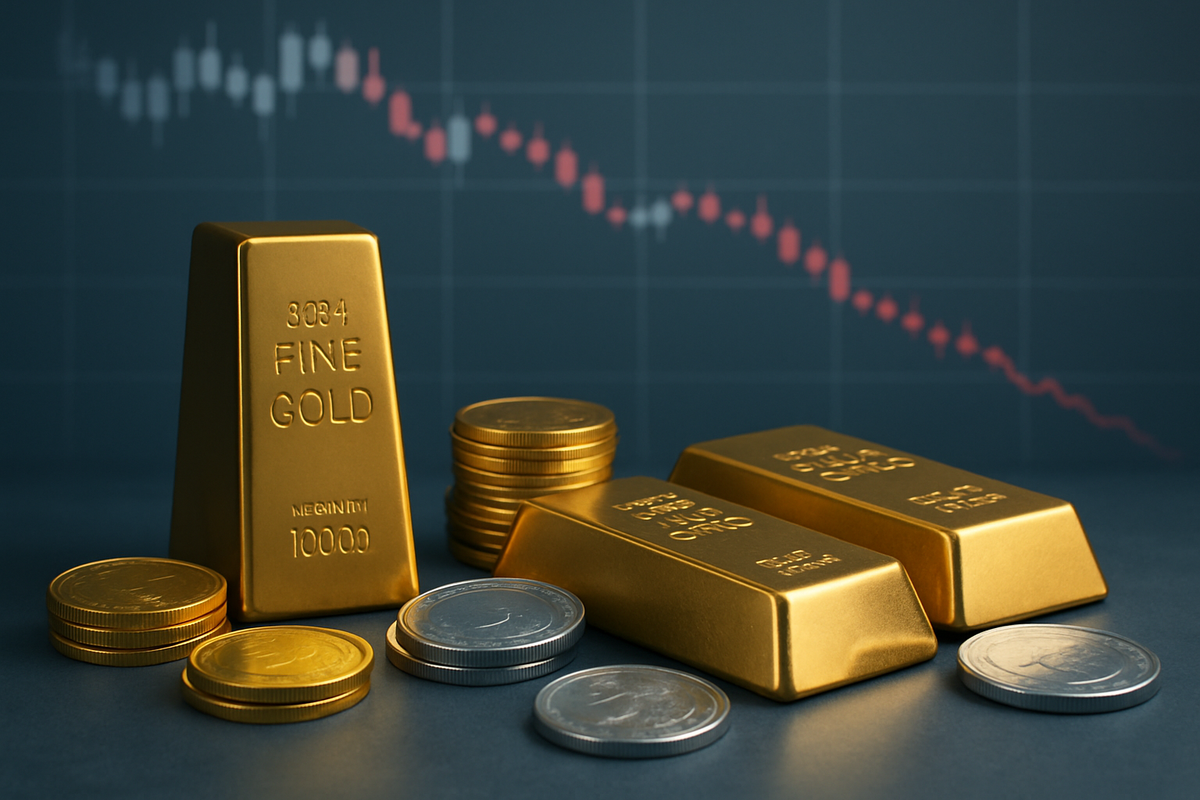
New York, NY – October 21, 2025 – The glittering rally in gold and silver, which saw both precious metals scale unprecedented heights throughout 2025, has hit a significant snag. Investors are aggressively locking in substantial profits, triggering the steepest one-day declines in years for both commodities. This dramatic reversal comes amidst growing concerns that the extended run-up has led to unsustainable valuations, prompting a widespread re-evaluation of positions in the safe-haven assets.
The correction, particularly pronounced on October 21, 2025, reflects a critical juncture in the precious metals market. After months of robust gains fueled by geopolitical uncertainties, strong central bank buying, and expectations of aggressive monetary easing, the market appears to be taking a breather. The swift and sharp downturn signals a shift in investor sentiment, moving from enthusiastic accumulation to cautious profit-taking, as the specter of overvaluation looms large.
Gold and Silver's Ascent and Abrupt Retreat
The journey for precious metals in 2025 was nothing short of spectacular. Gold, the traditional safe-haven asset, surged past the US$4,000 per ounce mark for the first time on October 7, ultimately touching an all-time nominal high of approximately US$4,380 to US$4,398 per ounce just days before the correction. This represented a staggering 60-65% increase year-to-date. Silver, often seen as gold's more volatile counterpart, outshone its peer in percentage terms, rocketing nearly 80% higher in 2025. It shattered its long-standing US$50 per ounce ceiling to reach an all-time high of US$54.3775 per ounce in mid-October.
Several powerful catalysts propelled this rally. Persistent global geopolitical and economic uncertainties fueled a strong demand for safe-haven assets. Central banks globally engaged in sustained and robust purchases, underpinning gold prices. Investment demand also soared, evidenced by substantial inflows into gold and silver exchange-traded funds (ETFs). Expectations of aggressive interest rate cuts by the US Federal Reserve later in the year made non-yielding assets more attractive, while a period of US dollar weakness further bolstered their appeal. Silver, in particular, benefited from burgeoning industrial demand from the green energy sector, including solar panel manufacturers and electric vehicles, coupled with persistent supply deficits.
However, the latter half of October 2025 witnessed a dramatic shift. On October 21, 2025, spot gold plummeted by as much as 6% to 6.3%, settling around US$4,082 to US$4,100 per ounce – its largest single-day percentage decline since 2013. Silver mirrored this precipitous fall, diving by up to 8.7%, its sharpest one-day drop since February 2021, settling around US$47.89 to US$50.96 per ounce. This sharp reversal was primarily attributed to widespread investor profit-taking after an extended nine-week rally and mounting concerns over the sustainability of such rapid gains. Analysts, including Bart Melek, global head of commodity strategy at TD Securities (TSX: TD), noted that "trend followers and dealers are taking profits after a very robust rally."
Impact on Public Companies and Market Players
The recent correction in precious metals prices will undoubtedly create winners and losers among public companies and market participants. Mining companies, particularly those with high production costs or significant debt, could face immediate pressure. For instance, major gold miners like Barrick Gold Corporation (NYSE: GOLD) and Newmont Corporation (NYSE: NEM) might see their share prices react negatively to sustained lower gold prices, impacting their profitability margins and future exploration budgets. Similarly, silver miners such as Pan American Silver Corp. (NASDAQ: PAAS) and Wheaton Precious Metals Corp. (NYSE: WPM) could experience similar headwinds. However, companies with robust balance sheets and efficient operations might be better positioned to weather the storm, potentially even acquiring distressed assets at lower valuations.
Conversely, some entities could benefit from the increased volatility. Brokerage firms and trading platforms that facilitate commodity trading may see an uptick in trading volumes as investors adjust their portfolios. Investment funds and ETFs that short precious metals or employ hedging strategies could also realize gains. Furthermore, a more stable, albeit lower, price environment might encourage industrial users of silver, such as solar panel manufacturers or electronics companies, to increase their purchases, potentially boosting demand in the long run. Retail jewelers, who may have faced higher input costs during the rally, could see some relief, potentially improving their margins and making precious metal products more affordable for consumers.
The correction also affects investors holding precious metals ETFs. For example, the SPDR Gold Shares (NYSEARCA: GLD) and iShares Silver Trust (NYSEARCA: SLV) have seen significant inflows during the rally. Now, these ETFs are likely experiencing outflows as investors liquidate positions, potentially impacting their net asset values and underlying holdings. The volatility might also attract new types of investors looking to buy on dips, suggesting a potential rotation within the investor base rather than a complete abandonment of the asset class.
Wider Significance and Market Repercussions
This significant correction in precious metals prices fits into a broader narrative of market cycles and investor behavior. It underscores the inherent volatility of commodity markets, particularly after extended periods of rapid appreciation. The swiftness of the decline, following such a strong rally, serves as a classic example of "buy the rumor, sell the news" or, in this case, "sell the peak." It highlights how quickly sentiment can shift from euphoria to caution when technical indicators signal an "overbought" market and fundamental drivers begin to normalize.
The ripple effects could extend beyond the precious metals sector. A stronger US dollar, cited as one factor contributing to the profit-taking, could impact other dollar-denominated commodities, potentially leading to broader corrections in energy and agricultural markets. Easing geopolitical tensions, such as hopes for an end to the US government shutdown and a de-escalation of US-China trade tensions, diminish the safe-haven appeal of gold and silver, encouraging investors to reallocate capital to riskier, growth-oriented assets. This could signal a broader rotation from defensive to cyclical assets in the equity markets.
Historically, sharp corrections after major rallies are not uncommon in precious metals. For instance, the gold market experienced similar dramatic reversals after its peaks in the late 1970s and early 2010s. These precedents suggest that while the current downturn is steep, it does not necessarily signal the end of precious metals as a viable asset class but rather a necessary recalibration. Regulatory bodies will likely monitor market stability, though direct policy implications are minimal unless volatility escalates to systemic levels. The key takeaway is that such events often prune speculative froth, leaving a more fundamentally driven market.
What Comes Next: Navigating the Volatility
In the short term, the precious metals market is likely to remain highly volatile as investors digest the recent correction and re-evaluate their strategies. We could see further price consolidation or even additional dips as the market seeks a new equilibrium. Investors should prepare for continued price swings and potentially lower trading volumes in the immediate aftermath. The strength of the US dollar and any new developments in global economic data or geopolitical events will be critical determinants of near-term price action.
Looking further ahead, the long-term outlook for precious metals will depend on a confluence of factors. If global economic uncertainties persist or central banks continue their accommodative monetary policies, demand for gold and silver as inflation hedges and safe havens could re-emerge, leading to a gradual recovery. Conversely, a sustained period of global economic growth and rising real interest rates could dampen the appeal of non-yielding assets. Strategic pivots for mining companies might include focusing on cost efficiencies, optimizing existing operations, and selectively pursuing high-grade projects. Investors might also increasingly turn to derivative markets to hedge against price fluctuations.
Potential market opportunities may emerge for value investors looking to buy on dips, particularly if prices fall to levels supported by production costs or strong industrial demand for silver. However, challenges will include managing increased price risk and accurately forecasting macroeconomic shifts. Scenarios could range from a quick rebound if safe-haven demand reignites, to a prolonged period of sideways trading, or even a deeper correction if fundamental drivers weaken significantly. The ability of central banks to manage inflation and interest rates will be paramount in shaping these outcomes.
Comprehensive Wrap-up and Future Outlook
The recent sharp correction in gold and silver prices marks a pivotal moment, signaling a shift from a prolonged bullish rally to a phase of profit-taking and market recalibration. The key takeaway is that while the ascent of precious metals in 2025 was impressive, concerns over potential overvaluation and easing safe-haven demand ultimately triggered a significant pullback. This event underscores the importance of prudent risk management and the cyclical nature of commodity markets.
Moving forward, the market will likely navigate a period of increased volatility and uncertainty. Investors should assess their exposure to precious metals, considering the potential for further price adjustments. The long-term significance of this event lies in its role as a necessary cleansing of speculative excesses, potentially paving the way for a more sustainable, fundamentally driven market. The dramatic price movements serve as a potent reminder that even safe-haven assets are not immune to market corrections.
Investors should closely watch key indicators such as central bank monetary policy decisions, global inflation trends, geopolitical developments, and the strength of the US dollar. Any significant shifts in these areas could provide new catalysts for either a renewed rally or further downward pressure. Additionally, monitoring industrial demand for silver and production costs for mining companies will offer insights into the underlying supply-demand dynamics. The coming months will be crucial in determining whether this correction is a temporary pause or the beginning of a more extended consolidation phase for gold and silver.
This content is intended for informational purposes only and is not financial advice






